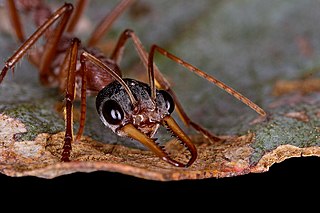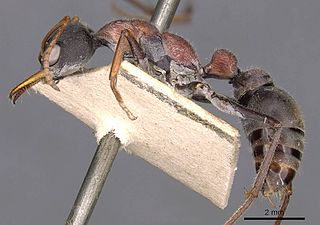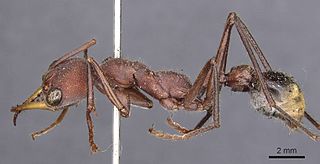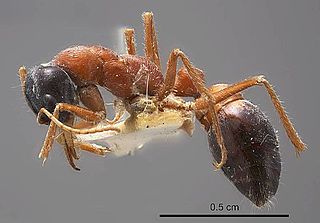
Myrmecia is a genus of ants first established by Danish zoologist Johan Christian Fabricius in 1804. The genus is a member of the subfamily Myrmeciinae of the family Formicidae. Myrmecia is a large genus of ants, comprising at least 93 species that are found throughout Australia and its coastal islands, while a single species is only known from New Caledonia. One species has been introduced out of its natural distribution and was found in New Zealand in 1940, but the ant was last seen in 1981. These ants are commonly known as bull ants, bulldog ants or jack jumper ants, and are also associated with many other common names. They are characterized by their extreme aggressiveness, ferocity, and painful stings. Some species are known for the jumping behavior they exhibit when agitated.

Myrmeciinae is a subfamily of the Formicidae, ants once found worldwide but now restricted to Australia and New Caledonia. This subfamily is one of several ant subfamilies which possess gamergates, female worker ants which are able to mate and reproduce, thus sustaining the colony after the loss of the queen. The Myrmeciinae subfamily was formerly composed of only one genus, Myrmecia, but the subfamily was redescribed by Ward & Brady in 2003 to include two tribes and four genera. An additional three genera, one form genus, and 9 species were described in 2006 from the Early Eocene of Denmark, Canada, and Washington. Subsequently an additional fossil genus was moved from the family Rhopalosomatidae in 2018, and a new genus was described in 2021.
Myrmecia inquilina is a species of ant endemic to Australia in the subfamily Myrmeciinae, first discovered in 1955 and described by Athol Douglas and William Brown Jr. in 1959. These ants are large, measuring 21.4 millimetres (0.84 in). During the time of its discovery, Douglas and Brown announced M. inquilina as the first social parasite among the primitive subfamilies, and today it is one of the two known Myrmecia species to have no worker caste. Two host species are known, Myrmecia nigriceps and Myrmecia vindex. Aggression between M. inquilina and its host species does not occur, and colonies may only produce M. inquilina brood months after the inquiline queens begin to lay their eggs. Queens eat the colony brood or trophic eggs, and other Myrmecia species may kill M. inquilina queens if they reject them. Due to its restricted distribution and threats to its habitat, the ant is "vulnerable" according to the IUCN Red List.

Myrmecia nigriceps, also known as the black-headed bull ant, is a species of ant endemic to Australia. A member of the genus Myrmecia in the subfamily Myrmeciinae, it was first described by Austrian entomologist Gustav Mayr in 1862. These ants are large, varying from 19 to 23 millimetres in length. However, colonies contain workers that are much smaller, usually half the size of normal workers. The queens are the largest while the males are the smallest, which can be easily identified due to their small mandibles.

Myrmecia vindex is a species of Myrmecia which is endemic to Australia. As a subgroup of the Myrmecia gulosa species group, these ants are also commonly known as the Bull Ant. The Myrmecia vindex was collected and described by Frederick Smith in 1858.

Myrmecia nigrocincta, commonly known as the jumper ant or jumping jack, is an ant of the genus Myrmecia. The species was first described by Frederick Smith in 1858. Colonies of this ant are abundant in eastern Australia. Ants of this species are known for their ability to jump up to 10 centimetres, and they also have a powerful, venomous sting. Rather than foraging on the ground, M. nigrocincta prefer to forage in trees where they are known to pollinate certain flowers.

Myrmecia tarsata is a bull ant species native to Australia. The species belongs to the genus Myrmecia. Their distribution is large, mainly around New South Wales and the Australian Capital Territory.

Myrmecia harderi is an Australian bull ant species which is part of the genus Myrmecia. They are native to Australia. They are mainly distributed in New South Wales, and some parts of Victoria, South Australia, and Queensland.

Myrmecia minuscula is an Australian ant which belongs to the genus Myrmecia. This species is native to Australia. They are distributed in the state of Queensland. They were described by Forel in 1915.

Myrmecia piliventris, the golden tail bull ant, is an Australian ant which belongs to the genus Myrmecia. This species is native to Australia. The Myrmecia piliventris is distributed Australia wide, but they're not too common in the western regions of Australia.

Myrmecia chasei is an Australian ant which belongs to the genus Myrmecia. This species is native to Australia. The Myrmecia chasei has a large presence and distribution in the south-eastern areas of Western Australia.

Myrmecia cephalotes is an Australian ant which belongs to the genus Myrmecia. This species is native to Australia. Myrmecia cephalotes has a large distribution in central South Australia and can be found in other regions of Australia.

Myrmecia regularis is a species of ant endemic to Australia. A member of the genus Myrmecia in the subfamily Myrmeciinae, it was first described by American entomologist Walter Cecil Crawley in 1925. These ants are medium to large in size, measuring 10 to 20 millimetres, and they are bright brownish-red in colour. Queens and workers share similar morphological features, but they can be distinguished by the noticeable size difference. Males also look similar, but collected specimens are too damaged to be examined properly.

Myrmecia froggatti is an Australian ant which belongs to the genus Myrmecia. This species is endemic to Australia. This species is distributed throughout all areas of New South Wales and elsewhere up north and south.

Myrmecia fuscipes is an Australian ant which belongs to the genus Myrmecia. This species is native to Australia. Their distribution is heavily observed in South Australia and Western Australia.

Myrmecia athertonensis is an Australian ant which belongs to the genus Myrmecia. This species is endemic to Australia. They are commonly spotted in the north of Queensland. It was described by Forel in 1915.

Myrmecia michaelseni is an Australian ant which belongs to the genus Myrmecia. This species is native to Australia. They are mostly distributed and studied in Western Australia.

Myrmecia swalei is an Australian ant which belongs to the genus Myrmecia. This species is native to Australia and is commonly distributed in Western Australia and South Australia. It was described by Crawley in 1922.

















